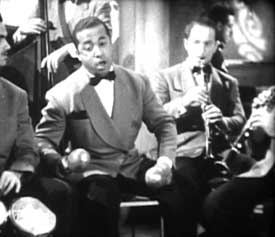 The undeservedly obscure Herbert Curbelo & His Orchestra I hope were more famous in Latin American countries generally, as he was just awfully good. The undeservedly obscure Herbert Curbelo & His Orchestra I hope were more famous in Latin American countries generally, as he was just awfully good.
His orchestra performs Que Buena Es La Conga (How Good the Conga Is) (1943) while the dance team of Varios & Vida dance & sway. The conga wouldn't be that interesting a dance for two, so they actually perform a rhuma.
When Curbelo begins to sing the lyrics, he remains in the background shaking his maracas. The dancers retain the camera's attention. The set is quite elaborate, looking like a Spanish courtyard. As the number ends, Varios & Vida dance out of the enclosed courtyard through a gate.
Curbelo is much more the center of attention of another soundie, when he performs the Cuban classic Babalu (1943) in Spanish. There's a piano solo at the instrumental break, from a pianist with the most amazing long spidery fingers.
Herbert as vocalist with maracas begins seated with his small orchestra, between bongo & clarinet, then stands to do a smooth slow swaying dance as he continues to sing ever so sweetly, creating the mood of a romantic tropical night.
It's actually a song to a voudon deity rather than the mere romantic song it sounds like to whoever doesn't speak Spanish. The lyrics translate, in part: "Jungle drums were madly beating/ In the glare of eerie lights/ While the natives kept repeating/ Ancient jungle rites."
Curbelo does not give the shout-out to "Babalu!" one hears in the famous Desi Arnaz version, so that Curbelo provides a much more peacefully sweet prayer to the Goddess of Love. A wonderful tune by a wonderful performer who I wish I could see a bit more of.
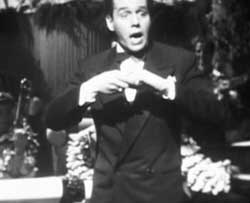 Tropical Swing (1947) was a one-reel home-movie release from Castle Films, consisting of songs excerpted from the feature Cuban Pete (1946) starring Desi Arnaz. Tropical Swing (1947) was a one-reel home-movie release from Castle Films, consisting of songs excerpted from the feature Cuban Pete (1946) starring Desi Arnaz.
The condensed version includes the King Sisters' version of "Cielito Lindo" backed by Desi's orchestra, & Ethel Smith on organ playing "The Breeze & I" to a dinner club crowd.
The latter is an amazing piece of exotica jazz. The delictibly beautiful Ethel Smith gets a most unusual sound out of her Hammond organ, seated at the bench wearing a flowing gown, on a slowly turning pedestal with some of the shots from above or at odd angles, quite pretty. The performance is stand-alone & not really integrated into the film.
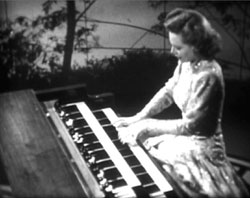 Even the close ups of Ethal's feet prancing along the petals is beautiful. This slim gal's hands dash about the two-level keyboards with grace & facility, creating a eerie melody that evokes the stormy Sahara. Even the close ups of Ethal's feet prancing along the petals is beautiful. This slim gal's hands dash about the two-level keyboards with grace & facility, creating a eerie melody that evokes the stormy Sahara.
Exotica at its best is wonderful stuff, but was always regarded a little kitschy & of specialized interest among a rare breed of jazz afficianados. Ethel's a great introduction to the musical form.
The King Sisters & especially Ethel Smith are great, but the heart of the film is Desi's medley of songs.
Curtains part & a harmony quartet of white gals with bows in their hairs are singing with fake Latina accents: "If you have a feeling for a Latin crime/ Then get set good people for a lovely time/ Hang on to your dollah, it won't cost a dime/ Here's a chap who'll take you there in song & rhyme."
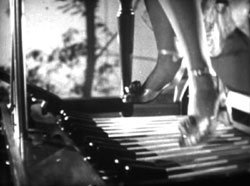 After this abysmal introduction, Desi Arnaz makes his appearance & begins to sing: "I'll take you where/ The nights are gay/ And when you're there/ You'll want to stay/ Have you ever been south of the Rio Grande/ And find the temperature is rising to beat the band/ When a lovely seniorita, she holds your hand/ Down South American Way." After this abysmal introduction, Desi Arnaz makes his appearance & begins to sing: "I'll take you where/ The nights are gay/ And when you're there/ You'll want to stay/ Have you ever been south of the Rio Grande/ And find the temperature is rising to beat the band/ When a lovely seniorita, she holds your hand/ Down South American Way."
It's not a great song but Desi has genuine charisma, singing in a large nightclub setting with big-band back-up from the Desi Arnaz Orchestra. This captures a real feeling of his mid-to-late '40s floor show at Ciros & such niteclubs, because he really did like to sing medleys.
Presently he leaps into a nice rendition of "Brazil" beginning: "Come with me/ And you'll see/ What we do in Rio D/ Jinerrrrro," with quite a lively beat. Desi saunters near the tables, behaving flirtatiously at the edge of his floorshow.
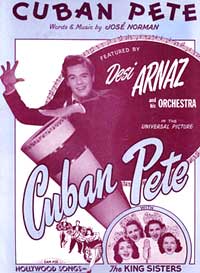 He then recites a rhymed litany of South American countries ending it with an invitation to Desi's own country, i.e., Koo-Bah. He puts on a straw hat handed to him by a musician & closes with the best of the three songs, his 1946 hit: He then recites a rhymed litany of South American countries ending it with an invitation to Desi's own country, i.e., Koo-Bah. He puts on a straw hat handed to him by a musician & closes with the best of the three songs, his 1946 hit:
"They call me Cuban Pete/ I'm the king of the rhumba beat/ When I play the maraccas I go chick-chicky-boom chick-chicky-boom./ Yes sir I'm Cuban Pete/ I'm the craze of my native street/ When I start to dance everything goes chick-chicky-boom chick-chicky-boom," & so on, full to the brim with character.
The full hour-long feature film Cuban Pete is not presently available on video. The comedy story deleted from the condensation is no great loss, as it's just a very slim romance (Joan Shawlee the leading lady) providing an excuse to get Desi's band to New York for a performance.
But the full version has much more music, including Desi's conga line number which conveys nicely the fact that Desi was the one who introduced this conga line to American dance clubs. Also featured are the dancers Igor Ega & Yvette von Koris.
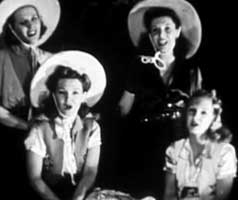 The King Sisters are backed by Alvino Rey & His Orchestra for The Call of the Canyon (1941). The King Sisters are backed by Alvino Rey & His Orchestra for The Call of the Canyon (1941).
The four harmonizing beauties are wearing cowgirl outfits with big hats, & the number is doubtless supposed to be western swing but there's not that much western remaining in their revamping of the Gene Autry hit from the film Melody Ranch (1940).
"Standing there alone by the ashes of a fire we said would never die/ We'll find an ember burning from the days gone by/ Then I hear a lonely whisper as a new spark I see/ It's the call of the canyon bringing back your answer to me."
Compared to the Boswell Sisters or even the Andrew Sisters, the four King gals don't harmonize all that perfectly, & their little solo lines are kind of squalling. So not top of the line for this sort of thing, but pleasant enough.
As they "woo oo oo" at the close, however, a coyote replies in the distance, which could be interpreted as a commentary on the performance.
This soundie was included in the home-viewing release of three soundies from Official Films, as The Call of the West (1947). The other inclusions wereThe Texas Strip (1942) featuring a gal grabbed out of some chorus line, Margie Beeler, to have her clothes torn off piece by piece by a Bob Manners with a bullwhip; & There Is No Shunsine (1945) featuring Tex Williams out in front of Spade Cooley & His Western Dance Gang.
Alvino Ray & His Orchestra also back up the King Sisters ruining St. Louis Blues (1941).
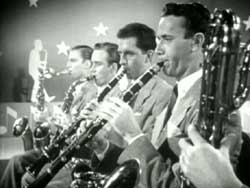 Opening with a reed section of saxophones & clarinets, the genuinely sleepy sound of Sleepy Lagoon (1942) is showing us Sunny Dunham & His Orchestra.
Opening with a reed section of saxophones & clarinets, the genuinely sleepy sound of Sleepy Lagoon (1942) is showing us Sunny Dunham & His Orchestra.
As the camera cuts to a more distant shot to show the whole orchestra, it's quite appealingly arranged for visual impact, with cut-outs affixed to the wall of sax players, five-point stars, & a huge moon with musical cleft on the bottom of the crecent.
The music for this composition was by Sir Eric Coates, a British classical pianist who published it without lyrics. In America when Jack Lawrence heard the melody, he was inspired to write the lyric, but could not get it published or performed because he did not have Coates' permission to write lyrics to the tune.
Being the war years it was hard to reach Coates in England, but when Lawrence did finally reach him, the classisist was delighted. The song was republished with lyrics & became a hit for the Harry James Orchestra in 1942, then for additional bands.
Sonny Dunham's orchestra covered it specifically for the soundie. It begins as a pleasing slow instrument then Ray Kellogg strolls center stage, joining Sonny who is wearing spats & holding his trumbone as he conducts.
"A sleepy lagoon. A tropical moon/ And two on an island/ A sleepy lagoon/ And two hearts in tune/ In some lullabyland./ The fireflies' gleam, reflects in the stream/ They sparkle and shimmer/ A star from on high/ Falls out of the sky/ And slowly grows dimmer.
"The leaves from the trees/ All dance in the breeze/ And float on the ripples/ We're deep in a spell/ As nightingales tell/ Of roses & dew./ The memory of/ This moment of love/ Will haunt me forever/ A tropical moon/ A sleepy lagoon -- & you."
Ray is a handsome fellow but with vaguely eerie eyes, which makes him all the better for a filmed presentation. He was an actor as well as a singer, & appeared in lots of films & television episodes, though not many notable roles.
As he sings the lyrics, the scene cuts to a tropical beach, with a beautiful maiden lounging on the sand, Ray still in his suit & his hands deep in his pockets but wearing an absurdly large flower leigh.
The beautiful gal is Anita Camargo. Soundies loved to include a little skin wherever they could, & a dancer was the easiest way, but Anita just models without dancing, without even standing up, quite lovely at it too. Like Ray, she was turning out for movie roles pretty regularly, without scoring big ones.
Anita can be glimpsed in Casablanca (1942) in an uncredited role as another character's arm-candy. Though she doesn't strike me as exotic enough to be playing a Polynesian girl in a soundie, it was actually just the kind of background-cast role she was getting in Hollywood, playing Mexican senoritas.
Ray kneels down beside her on the sand as the scene returns to the moon-backdrop stage & Sunny's conclusion with a trumpet solo emulating Harry James' horn solo on the first charting hit of this song. I'd really hoped Sunny would keep the trumbone for the solo so it'd be a little different.
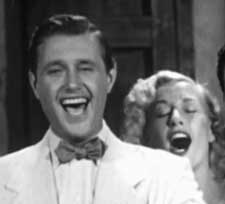 Seated in a bandbox, a quintet is performing, the members in their straw hats consisting of a guitarist, trumpeter, trumbonist, pianist, & slap bass. The rest of the stage is decked out as a small restaurant with two couples at two small tables.
Seated in a bandbox, a quintet is performing, the members in their straw hats consisting of a guitarist, trumpeter, trumbonist, pianist, & slap bass. The rest of the stage is decked out as a small restaurant with two couples at two small tables.
The unnamed quintet has that Coney Island fake-dixieland sort of look & one expects they'll make a racket. But in reality they're subdued because they're the back-up band for vocalist Carl Ravazza who strolls out to stand between the two tables & sing this Snader telescription's title song Tampico (1951).
Ravazza is kind of cute in a "complete dork" manner, a teeny-tiny black bowtie on his starched collar with white jacket. He gives a totally bland rendition with a big smile but no life in his voice as he informs us, "Tampico. Tampico/ That's the place to go/ Tampico. Tampico, where banana boats all go."
Hard to believe a song this crappy that rhymes "go" with "go" could've been something of a standard for a while, but not everyone interpretted it quite this badly. Most versions are very much goofy novelty song performances, but Carl seems to be under the misguided impression that he's singing a serious composition.
It improves somewhat when the two couples at two tables stand & begin to harmonize with Carl. This singing groupe is called the Double-Daters, & the two guys are wearing shiny blossoming shirts to sort of match the low-bust-line shiny dresses of the two gals.
The Double-Daters had recorded with Frank Sinatra in 1949, & Carl may have felt the glamour rub off on him, but they're really not that good. They flank Carl, match his idiot's grin, relieving him from having to carry the song totally on his own, though he still solos after the chorus.
They all end the number on the squalliest warbled "AHHH!" with their mouths stretched wide to catch flies, & aren't even doing the tune anymore. So crappy it's kind of fun -- once.
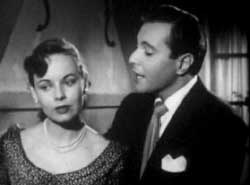 Unusually staged I Don't Want to Walk Without You (1942) opens with a film noir look as singer Dick Brown snuffs a cigarette, then goes to the door to greet his girl & begin singing the Eddy Arnold hit: "I don't want to walk without you, baby/ Walk without my arms about you, baby..."
Unusually staged I Don't Want to Walk Without You (1942) opens with a film noir look as singer Dick Brown snuffs a cigarette, then goes to the door to greet his girl & begin singing the Eddy Arnold hit: "I don't want to walk without you, baby/ Walk without my arms about you, baby..."
The Jule Stine & Frank Loesser composition had only recently been introduced in the collegiate musical comedy thriller Sweater Girl (1942), where it had been sung by Johnnie Johnston & Betty Jane Rhodes. It became a big hit for the Harry James Orchestra with vocalist Hellen Forrest, then covered by many others to come.
Popular though the song was, it's a mite ordinary to my ear. Dick Brown is a pleasant crooner & quite handsome, but not a lot of vocal individuality.
He does turn in a better version of this number than is the case with another soundie, Kay Lorraine's I Don't Want to Walk Without You (1942).
Another noirish beginning is given to Bob Haymes' telescription I'll Never Smile Again (1951). Bob was an actor-singer-songwriter & the younger brother of singer/actor Dick Haymes.
He sang for the Carl Hoff Orchestra & Bob Chester Orchestra in the '40s. He appeared in about twenty films & in 1952 starred in a television situation comedy about two goofball song writers, It's a Business (1951-1952).
In I'll Never Smile Again, he's on the phone failing to get hold of his girlfriend. The music rises at first like suspense music as Bob leaves the phone off the hook & grabs his suitcase to stuff with a few things for travel.
He begins singing the title song, looking ridiculously serious & hugging the phone to his ear. He sounds a bit like Perry Como & wouldn't seem quite so silly if he hadn't been forced to "act" with the phone.
At last he hangs up the phone, but as he finishes the number, his gal comes in the door for a happy ending. And he smiles. Pleasantly goofy, though when Ruth Lowe wrote it, it was in all seriousness after the loss of her first husband, Harold Cohen.
The Ruth Lowe composition was a minor hit for Bob Haymes, but it had been a giant hit for Frank Sinatra in 1940 while singing for Tommy Dorsey's band. However, Percy Faith's orchestra had been popularizing the tune the year before in live performances & on radio. One of the best versions is by the Inkspots. It remains to this day a swing jazz standard.
copyright © by Paghat the Ratgirl
|
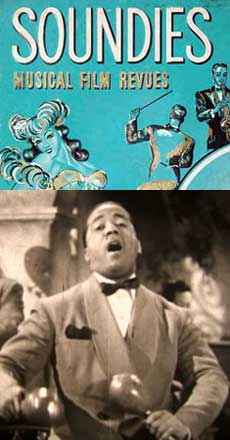


 Even the close ups of Ethal's feet prancing along the petals is beautiful. This slim gal's hands dash about the two-level keyboards with grace & facility, creating a eerie melody that evokes the stormy Sahara.
Even the close ups of Ethal's feet prancing along the petals is beautiful. This slim gal's hands dash about the two-level keyboards with grace & facility, creating a eerie melody that evokes the stormy Sahara. After this abysmal introduction, Desi Arnaz makes his appearance & begins to sing: "I'll take you where/ The nights are gay/ And when you're there/ You'll want to stay/ Have you ever been south of the Rio Grande/ And find the temperature is rising to beat the band/ When a lovely seniorita, she holds your hand/ Down South American Way."
After this abysmal introduction, Desi Arnaz makes his appearance & begins to sing: "I'll take you where/ The nights are gay/ And when you're there/ You'll want to stay/ Have you ever been south of the Rio Grande/ And find the temperature is rising to beat the band/ When a lovely seniorita, she holds your hand/ Down South American Way." He then recites a rhymed litany of South American countries ending it with an invitation to Desi's own country, i.e., Koo-Bah. He puts on a straw hat handed to him by a musician & closes with the best of the three songs, his 1946 hit:
He then recites a rhymed litany of South American countries ending it with an invitation to Desi's own country, i.e., Koo-Bah. He puts on a straw hat handed to him by a musician & closes with the best of the three songs, his 1946 hit:


